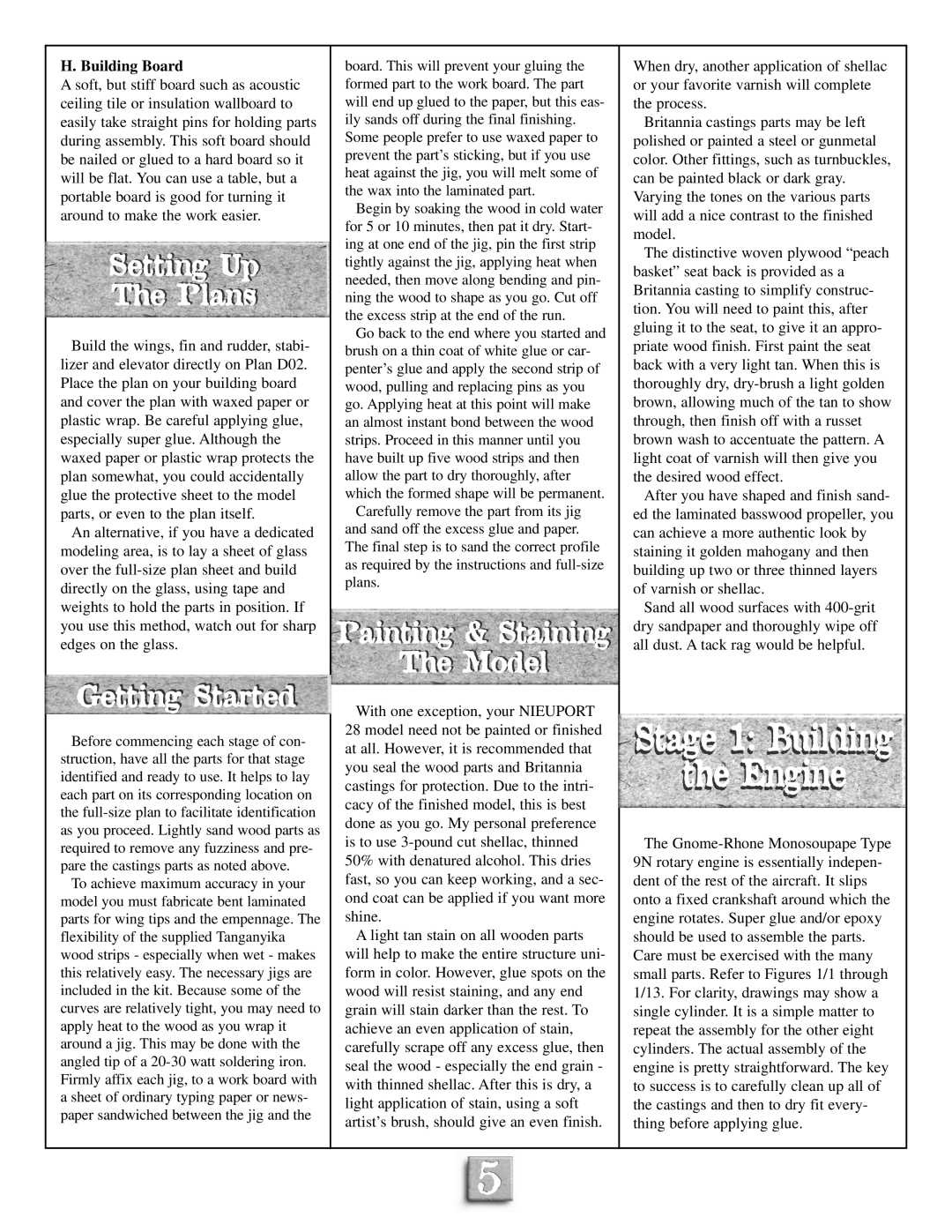
H. Building Board
A soft, but stiff board such as acoustic ceiling tile or insulation wallboard to easily take straight pins for holding parts during assembly. This soft board should be nailed or glued to a hard board so it will be flat. You can use a table, but a portable board is good for turning it around to make the work easier.
Setting Up
The Plans
Build the wings, fin and rudder, stabi- lizer and elevator directly on Plan D02. Place the plan on your building board and cover the plan with waxed paper or plastic wrap. Be careful applying glue, especially super glue. Although the waxed paper or plastic wrap protects the plan somewhat, you could accidentally glue the protective sheet to the model parts, or even to the plan itself.
An alternative, if you have a dedicated modeling area, is to lay a sheet of glass over the
Getting Started
Before commencing each stage of con- struction, have all the parts for that stage identified and ready to use. It helps to lay each part on its corresponding location on the
To achieve maximum accuracy in your model you must fabricate bent laminated parts for wing tips and the empennage. The flexibility of the supplied Tanganyika wood strips - especially when wet - makes this relatively easy. The necessary jigs are included in the kit. Because some of the curves are relatively tight, you may need to apply heat to the wood as you wrap it around a jig. This may be done with the angled tip of a
board. This will prevent your gluing the formed part to the work board. The part will end up glued to the paper, but this eas- ily sands off during the final finishing. Some people prefer to use waxed paper to prevent the part’s sticking, but if you use heat against the jig, you will melt some of the wax into the laminated part.
Begin by soaking the wood in cold water for 5 or 10 minutes, then pat it dry. Start- ing at one end of the jig, pin the first strip tightly against the jig, applying heat when needed, then move along bending and pin- ning the wood to shape as you go. Cut off the excess strip at the end of the run.
Go back to the end where you started and brush on a thin coat of white glue or car- penter’s glue and apply the second strip of wood, pulling and replacing pins as you go. Applying heat at this point will make an almost instant bond between the wood strips. Proceed in this manner until you have built up five wood strips and then allow the part to dry thoroughly, after which the formed shape will be permanent.
Carefully remove the part from its jig and sand off the excess glue and paper. The final step is to sand the correct profile as required by the instructions and
Painting & Staining
The Model
With one exception, your NIEUPORT 28 model need not be painted or finished at all. However, it is recommended that you seal the wood parts and Britannia castings for protection. Due to the intri- cacy of the finished model, this is best done as you go. My personal preference is to use
A light tan stain on all wooden parts will help to make the entire structure uni- form in color. However, glue spots on the wood will resist staining, and any end grain will stain darker than the rest. To achieve an even application of stain, carefully scrape off any excess glue, then seal the wood - especially the end grain - with thinned shellac. After this is dry, a light application of stain, using a soft artist’s brush, should give an even finish.
When dry, another application of shellac or your favorite varnish will complete the process.
Britannia castings parts may be left polished or painted a steel or gunmetal color. Other fittings, such as turnbuckles, can be painted black or dark gray. Varying the tones on the various parts will add a nice contrast to the finished model.
The distinctive woven plywood “peach basket” seat back is provided as a Britannia casting to simplify construc- tion. You will need to paint this, after gluing it to the seat, to give it an appro- priate wood finish. First paint the seat back with a very light tan. When this is thoroughly dry,
After you have shaped and finish sand- ed the laminated basswood propeller, you can achieve a more authentic look by staining it golden mahogany and then building up two or three thinned layers of varnish or shellac.
Sand all wood surfaces with
Stage 1: Building
the Engine
The
5
